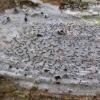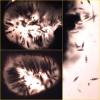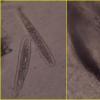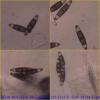
20-12-2025 23:08
Patrice TANCHAUDBonsoir, récolte sur sol sablonneux dans l'arri�

21-12-2025 09:32
Hello.A tiny ascomycete found embedded in wood in

20-12-2025 15:47
Mirek GrycHi.These grew on pine wood that was heavily covere

18-12-2025 21:17
Pol DebaenstThe identification took me to Byssonectria deformi

15-12-2025 07:09
 Danny Newman
Danny Newman
indet. Rutstroemiaceae sp. on unk. fallen leavesMc

19-12-2025 10:10
Patrice TANCHAUDBonjour, récolte réalisée en milieu dunaire, a

18-12-2025 17:23
 Bruno Coué
Bruno Coué
Bonjour,je serais heureux d'avoir votre avis sur c
I would like to have more opinions about this asco, that was growing on the thallus of a lichen (of the genus Graphis), as can be observed from the first photo attached. In addition there was another parasite with similar appearance over the lichen. I was doing the microscopy of the lichen and noticed some stranges spores. Then I selected a emerging volcano and made some sections of it. From the shape of the ascospores I immediatly thought that could be a Hysterium sp.. When I measured the spores I got a surprise, the size was about the double than expected (in average 52.4 x 12.8 µm). I went to the key of Eric Boehm, available at
http://www.eboehm.com/hysterium.html
and arrived to Hysterium macrosporum. Since till now I found only two Hysterium species: H. angustatum and H. pulicarea and, according to the description given in the above website, H. macrosporum it is a very rare species, I became doubtful. Is there any other suggestion?
Thank you in advance,
zaca
Hi Zaca,
H. macrosporum is not possible because ascospores are 2-coloured.
It's close to H. pulicare but different, to my mind. But there are a big variations in H. pulicare (for example, H. pulicare Pers. and H. truncatulum, one of its synonyme) and study would be necessary.
My opinion is that your fungus is probably an ined. fungus.
Alain
PS just a question : ascopores are in water in fourth picture ?
Ragarding your question the answer is: YES. All the observation was done with water.
Regards,
zaca




